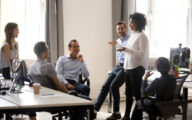
Children, Social work leaders, Workforce
‘A kick in the teeth’: DfE axes social work leadership training programme

Firm pulls out of providing service for council that union claims would have broken social work strike

Working with perpetrators of domestic abuse: training social workers to have challenging conversations

Social work leaders, Workforce
‘Why practice education research must be catalyst for tackling longstanding issues facing role’

Social work leaders, Workforce
National support programme for overseas social workers should be ‘seriously considered’, says BASW

Children, Social work leaders, Workforce
The Victoria Climbié Inquiry chair reflects on social work, 21 years on

Social work leaders, Workforce
Practice educators passionate about role, but lack of support risks pushing them out of it, finds study

Children, Social work leaders, Workforce
Seven more councils chosen to test family support and child protection reforms

Social work leaders, Workforce
BASW chief elected president of International Federation of Social Workers Europe
More articles
2
Job of the week
Polls
Workforce Insights
 Working with perpetrators of domestic abuse: training social workers to have challenging conversations
Working with perpetrators of domestic abuse: training social workers to have challenging conversations  Podcast: supporting adults with learning disabilities and autistic people post-pandemic
Podcast: supporting adults with learning disabilities and autistic people post-pandemic  ‘There aren’t many roles where you get to take a child on holiday’: the benefits of residential care work
‘There aren’t many roles where you get to take a child on holiday’: the benefits of residential care work  Podcast: moving on from Ofsted
Podcast: moving on from Ofsted  Workforce Insights – showcasing a selection of the sector’s top recruiters
Workforce Insights – showcasing a selection of the sector’s top recruiters













 A groundbreaking course preparing care leavers and other young people for independent living
A groundbreaking course preparing care leavers and other young people for independent living  Bournemouth, Christchurch and Poole
Bournemouth, Christchurch and Poole  Bradford Children and Families Trust
Bradford Children and Families Trust  Hampshire County Council
Hampshire County Council  Lincolnshire County Council
Lincolnshire County Council  Norfolk County Council
Norfolk County Council  Northamptonshire Children’s Trust
Northamptonshire Children’s Trust  South Gloucestershire Council
South Gloucestershire Council  Wiltshire Council
Wiltshire Council  Wokingham Borough Council
Wokingham Borough Council  West Sussex County Council
West Sussex County Council  A trauma-informed approach to social work: practice tips
A trauma-informed approach to social work: practice tips  Problem gambling: how to recognise the warning signs
Problem gambling: how to recognise the warning signs  Write for Community Care
Write for Community Care 
 Facebook
Facebook X
X LinkedIn
LinkedIn Instagram
Instagram